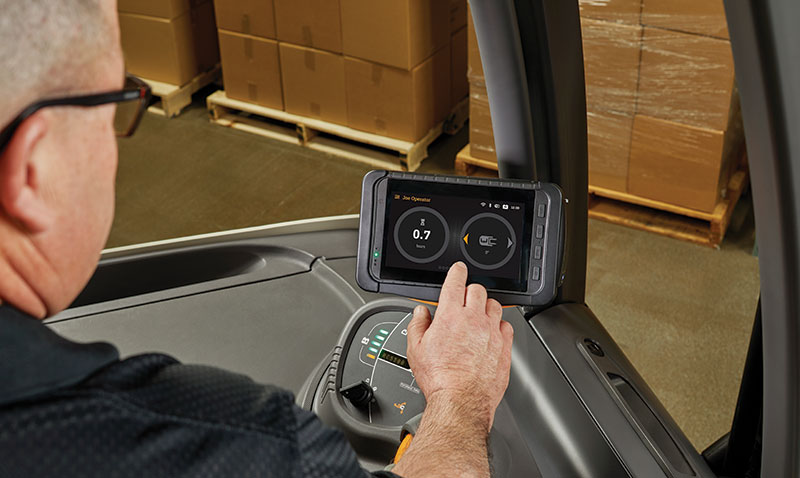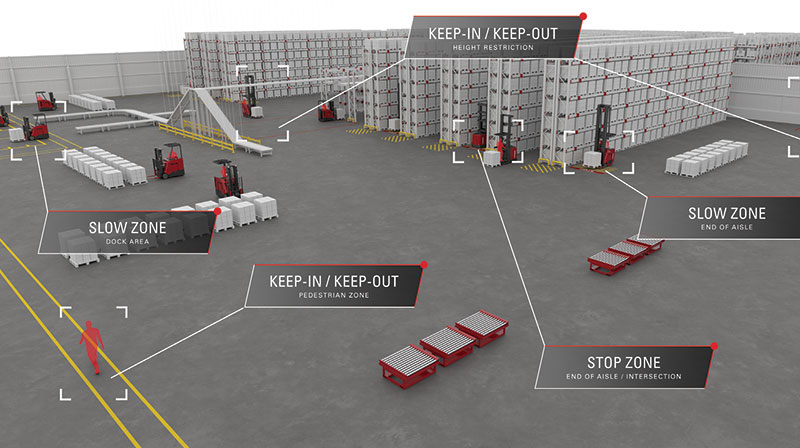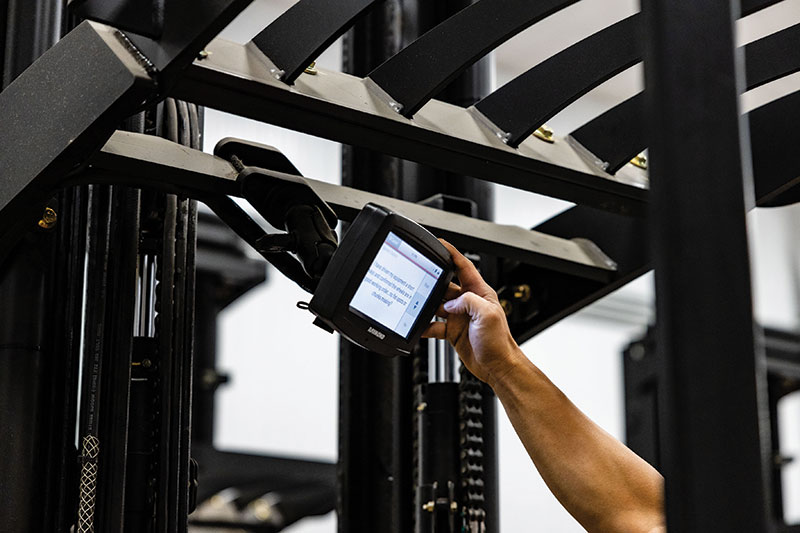Next-Level Lift Truck Telematics
Getting more out of lift truck telematics involves looking beyond basics and starting to incorporate analytics fed by integration with other systems. By marrying up telematics data from the trucks with operations data, or with real-time location feeds, users stand to benefit.
![]() Lift truck telematics has made its mark by turning lift trucks into connected assets. The core features of these solutions include impact monitoring and providing a digital record of safety incidents. The systems digitize safety checklists, rather than forcing operators and supervisors to fiddle with paper records.
Lift truck telematics has made its mark by turning lift trucks into connected assets. The core features of these solutions include impact monitoring and providing a digital record of safety incidents. The systems digitize safety checklists, rather than forcing operators and supervisors to fiddle with paper records.
In short, lift truck telematics solutions have caught on because they digitize key aspects of lift truck use.
But on its own, telematics doesn’t have the complete picture needed to optimize everything in a fleet’s operating environment, such as cross-referencing with data from a warehouse management system (WMS) or data from human resources systems or labor management system (LMS).
Now providers of telematics and fleet software are using application programming interfaces (APIs) and more advanced levels of business intelligence tools to marry telemetry data with other sources of data to feed analytics. According to telematics providers, these solution suites are getting more connected to other systems and providing deeper operational insights through the use of business intelligence (BI) and analytics tools, with the end goal of providing a safer, more productive fleet.
Telematics features such as digital safety checklists still have value, but integration and analytics are seen as a big part of additional value that can be derived from telematics and related fleet software.
“Capabilities such as impact monitoring, access control and a digitized OSHA safety checklist are getting to be pretty much table stakes now,” observes John Rosenberger, director of iWarehouse Gateway and global telematics for The Raymond Corp. “If you aren’t offering those capabilities as a provider, you’re really not delivering the full range of solutions operations are interested in.”  APIs—application programming interfaces—make it possible to automatically import data from systems such as human resources solutions so that onboarding new operators is streamlined.
APIs—application programming interfaces—make it possible to automatically import data from systems such as human resources solutions so that onboarding new operators is streamlined.
Operator-assist tech
Today, telematics and fleet software can tie into other systems such as real-time location services (RTLS) to alert operators of hazards and keep them in proper operating zones, explains Rosenberger. For example, Raymond’s iWarehouse suite uses RTLS to automatically alert operators if a lift truck is going into an area that is zoned as off-limits or height restricted due to an overhead obstruction such as an elevated walkway or a crane structure.
Such “operator assist” features are similar to the technology seen on many consumer cars and trucks, which leverage cameras and sensor technology to alert drivers to possible dangers, says Rosenberger. For a car, it might be another car in the driver’s blind spot, while in the lift truck operations world, it could be an alert about a pedestrian walking down the middle of a warehouse aisle or an alert to an operator if he or she is driving in an area the system has zoned as restricted.
“Real-time locating services helps the operator be more fully aware of their environment,” says Rosenberger. “There is still interest in traditional telematics data, but there is also this growing requirement to support what we call operator assist functions.”
Raymond’s telematics suite supports configurable zones, either to keep operators out of an area that poses a hazard or within the bounds of designated routes. This type of functionality, Rosenberger says, will be increasingly attractive due to growth of e-commerce. “E-commerce is really driving the requirement for, and further proliferation of, operator assist functions to help alert operators because of all the temporary labor and newer operators coming into these facilities,” Rosenberger says.
Different enabling technologies are involved in operator-assist features, Rosenberger explains. The iWarehouse RTLS capability uses a series of stationary mounted anchors and tags mounted to a movable object—such as Raymond forklifts, pedestrians or other assets—to determine the location of an object to within plus or minus 3 feet. Another feature of the solution suite known as iWarehouse ObjectSense uses sensors mounted on trucks to warn operators of unexpected hazards. The detection system can even slow a truck to a complete stop if an object gets too close.
Besides helping avoid incidents in the here and now, the data from RTLS or features like ObjectSense can be analyzed within iWarehouse to identify areas for process improvements, adds Rosenberger. “You can’t optimize what you don’t measure because you have no gauge or basis for it,” he says. “That is why it’s useful to have all the data coming into an integrated system, because I might want to make that information available to a facilities planning team, or for a lean manufacturing improvement effort.”
Integration helps in multiple ways, says Rosenberger. For example, if telematics is integrated with an HR system that holds training records and RTLS, then the operation can understand not only how many impacts or incidents have occurred, but where they occurred, the trucks and operators involved, and access to training records to see if the operator was fully updated on training.

By combining real-time location data with telematics, users can define zones that can enhance safety for both lift truck operators and for pedestrians.
This integration may show that further training is needed, or conversely, that the problem isn’t related to training or vehicle speed, but may call for a reassessment of layout or workflows in an area.
By integrating telematics and RTLS with labor management data, Rosenberger adds, an operation can dynamically understand how long tasks take and gain a better handle on cost to serve. For example, if inventory is reslotted in an area, integration between telematics, RTLS and labor standards in LMS or WMS can be used to automatically measure how much time tasks like order picking now take after the reslot, without having to do time studies.
“We think it’s better to have self-adjusting labor standards, where the cost to serve is accurately known, without having to go through the expense of time studies. Via integration, in the course of normal operations, you can update labor standards using the data your systems are already generating,” Rosenberger says.
Leveraging BI
As more technologies like automation, collision avoidance and real-time location options become part of telematics, more data can be analyzed for improvement, which is the end game for users, observes Collin Rush, director of InfoLink customer support with Crown Equipment Corp.
“What customers want is the data generated by these newer technologies,” Rush says. “They want to know if the data generated by these technologies can make the operation more productive or safer.”
For Crown’s InfoLink telematics solution users, three main things are being requested, says Rush: support for API-based integration to other systems to gain a fuller picture of trends; better business intelligence and analytics capabilities; and help with custom reports and key performance indicators (KPIs).
API-based integration can save users time, in some cases. For example, says Rush, API-based integration between InfoLink and HR systems can reduce administrative burden in onboarding new operators, because data that originates in an HR system can automatically feed into telematics.
Integration can also bring together disparate data sources to provide a fuller picture of fleet utilization and productivity, says Rush. For example, one of Crown’s telematics customers was using its QuickPick Remote order picking technology and a WMS, and was able to use APIs to bring these sources of InfoLink data into their database to analyze the percentage of time operators were using the remote order picking function (which allows for faster picking by letting operators stay on foot while they wirelessly advance the truck to the next task location) versus traditional manual order picking. This integration and the related reports help determine, and monitor, the optimal percentage of time operators should be using remote order picking to achieve the target pick rate, Rush says.
In essence, explains Rush, APIs enable data integration and business intelligence in telematics, which gives a more complete picture, because you can analyze truck-related data like travel time and lift time against operations data coming from systems like a WMS.
“Telematics tell you what is happening on the truck, and a customer’s WMS tells them what is happening from a pick standpoint—how much product they are moving. More advanced users may want to tie these data sources together and create KPIs to help make them more productive,” says Rush.
Making the most of telematics and fleet software can be daunting, especially when it comes to reporting and business intelligence, says Rush, so part of Crown’s focus is to help InfoLink users create custom reports and dashboards.
For example, one user wanted to closely track how much time each operator was simultaneously driving and lifting (known as “blending”), since this can present a safety hazard in some applications. Crown helped this user create a blending time report, in the format and frequency it wanted. “Sometimes, users are just trying to get that one KPI they don’t have to add to their safety or utilization bucket, and so, we will help them create it in the format they want, and at the frequency they want it, to drive better decisions,” says Rush.
In addition to helping create reports, Crown offers “performance services” for users, including periodic reviews, coaching sessions or monthly dashboards to show how a customer can more effectively leverage the system. These consulting services for telematics, Rush explains, typically are delivered about 90 days after the start of using the solution.

Integration between lift truck telematics solutions and systems including WMS can provide a fuller picture of fleet utilization and productivity.
“When a customer buys a telematics solution, they might not be ready to fully utilize all of the data that can be captured and integrated, especially on day one,” says Rush. “These services are designed to help all users, including operators and managers, stay engaged with the system, and to coach them on using it to be more successful.”
Analytics carry value, but it’s important to realize that basic telematics and fleet reporting can do much to improve compliance with safety regulations and help improve safety, which should remain a key focus, points out Tom Ryder, chief commercial officer at TFS, an OnPoint Group Company and a brand independent provider of turnkey fleet management services.
As part of its services, says Ryder, TFS leverages telematics, integrating the data directly into its proprietary fleet management software. Core telematics functions such as access control, safety checklist, impact management and operator monitoring are still the right starting point for most facilities—especially for larger, multi-shift fleets, advises Ryder, though analytics can follow these “Big Four” functions.
“When the full breadth of technology is harnessed such as labor management, preventative maintenance scheduling, utilization planning, cost per hour, indoor/outdoor vehicle tracking, route density, material flow, job monitoring and task selection, to name a few, we can unlock an immense amount of data that drives exponential value to a high-velocity facility,” Ryder says. “With fleet management software, these prescriptive analytics deliver insights that drive operator performance improvements and incentive programs for safer and higher productivity facilities such as cases moved per labor hour.”
Safety improvement should remain a primary focus in managing lift truck fleets, Ryder advises. “The data on safety is alarming,” he says. “Every three days someone is killed in a forklift related accident, and 25% of all industrial accidents occur at the loading dock area. Telematics can drive compliance and safety improvements quickly, and we advise teams start there. Cost and productivity metrics can then be additional levers and investments made after initial wins are realized.”
Part of the value in an outsourced fleet management arrangement, Ryder says, is that companies can focus on operations, not learning how to deploy and get the most out of telematics and fleet software. “That’s why we’ve built an entire team that designs, implements and manages telematics solutions as an additional service, integrated with our fleet management solutions,” he says.
AI-driven safety
While access control—digitizing who is authorized and trained to operate a lift truck and which operators have used specific trucks—is a well-established telematics feature, the Covid-19 pandemic has renewed focus on it for “chain of custody” reasons, says Mark Stanton, general manager of supply chain solutions at PowerFleet. Because access control generates a digital record of who operated each truck and when, this record supports contact tracing should an operator contract Covid, and the operation wants to pinpoint who used the same equipment. “It’s not necessarily the most advanced function we offer, but having this digital chain of custody over the equipment to assist with contact tracing is an added benefit of the technology, and it’s something some customers have made use of during the pandemic,” says Stanton.

Camera feeds to AI-based software hold the potential to alert operators of unseen or unnoticed hazards
Stanton agrees fleet analytics is an area of rapid advancement, with some users of PowerFleet’s solution leveraging analytics to help understand the connection between safety and productivity or throughput rate. “What many of our customers have been looking at through 2021 is really understanding what their utilization and productivity rates are, and then balancing that against safety,” Stanton says. “We help them identify where that peak opportunity exists for continuing to improve productivity, without negatively impacting safety.”
Integration of fleet telematics data and fleet analytics with WMS or enterprise resource planning (ERP) data is the best way to address concerns such as whether the makeup of the fleet aligns with the tasks and work requirements coming from the business system, Stanton adds.
“Integration with the back-end business system provides that holistic picture on issues like: Do I have the right types of machines available, not just in terms of the quantity of machines, but having them available at the right times in the right areas of the operation,” he says.
Larger enterprise customers of PowerFleet’s solution commonly use the system’s KPIs to compare how different sites are doing, Stanton adds. “We offer a set of metrics that provide a clear picture of the operational characteristics of each site, and that allows that enterprise to compare their best sites with underperforming ones and see if there are standard operating procedures that have worked well at one of its best sites that could be applied to other sites,” he says.
Overall, says Stanton, expect telematics and fleet software to continue to make advances in terms of BI and analytics, and in terms of sensors and operator assistive technologies.
PowerFleet has been testing on-board camera technology that uses artificial intelligence to rapidly spot and assess hazards, and warn the operator in time to avoid an incident. This AI-based camera technology can help avoid collisions with other lift trucks and with workers on foot, by serving as another set of eyes and risk cognition for the operator.
The same technology can interact with the truck and apply the brakes, if needed, as a last resort, though the intent is to assist busy operators, not take control of the truck. “We are trying to give them more information, so they can in effect see more and make better decisions in a timely manner,” says Stanton

Article Topics
Warehouse News & Resources
The Ultimate WMS Checklist: Find the Perfect Fit 40th Annual Salary Survey: Salary and satisfaction up Data Capture: Bar coding’s new companions Salary Survey: Pay, satisfaction, youth on the rise Examining the impact of the Taiwan earthquake on global supply chain operations Reverse Logistics: Best Practices for Efficient Distribution Center Returns Exploring Customized Forklift Solutions More WarehouseLatest in Logistics
DAT March Truckload Volume Index sees modest March gains National diesel average, for week of April 22, is down for the second straight week UPS reports first quarter earnings declines LM Podcast Series: Assessing the freight transportation and logistics markets with Tom Nightingale, AFS Logistics Investor expectations continue to influence supply chain decision-making The Next Big Steps in Supply Chain Digitalization Warehouse/DC Automation & Technology: Time to gain a competitive advantage More LogisticsAbout the Author
Subscribe to Logistics Management Magazine

Find out what the world's most innovative companies are doing to improve productivity in their plants and distribution centers.
Start your FREE subscription today.
April 2023 Logistics Management

Latest Resources
















